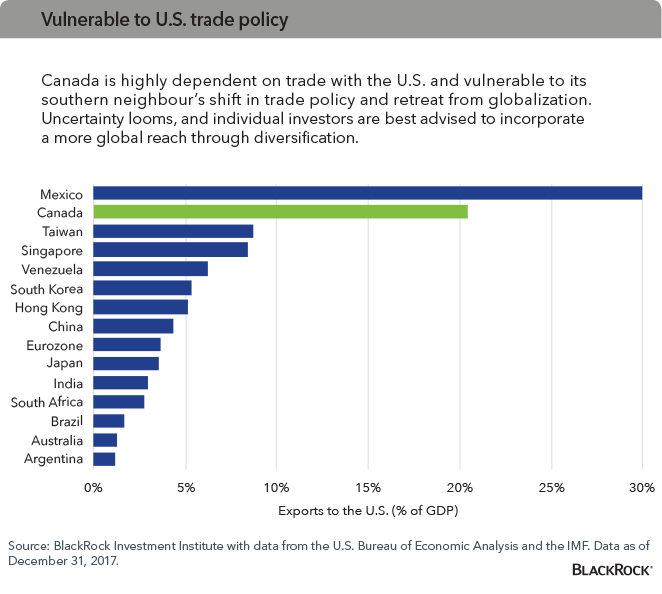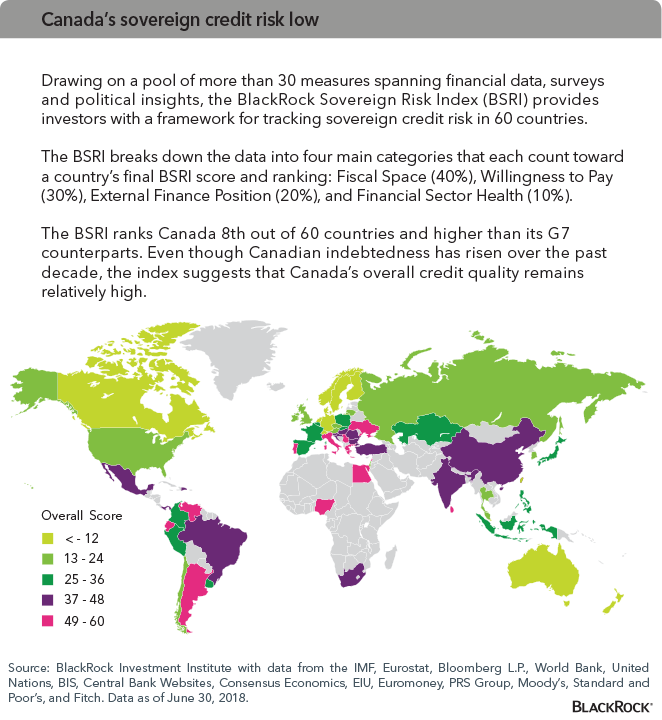by Kurt Reiman, Blackrock
Kurt discusses the long-run promise of Canada’s economy, but they see the economy hitched to trade developments – both interprovincial and international – and the direction of global interest rates.
The best of times?
The Canadian economy is expected to operate above potential for the next year, the unemployment rate is hovering near historic lows and wages are moving steadily higher. Against this constructive backdrop, the Bank of Canada will likely raise rates in October for the third time this year. But while the outlook appears generally constructive, the balance of risks could easily shift.
For a nation that has a 170% debt-to-income ratio1 – a level comparable to the US debt levels a decade ago preceding the financial crisis – rising interest rates could be a cause for concern. There is also the question of how to interpret the mixed signals from the labor market: a near record low unemployment rate, modest wage gains and the high share of part-time workers relative to new full-time employment. At the very least, the Bank of Canada will be forced to move slowly as long as inflation is under control.
Trade tensions
The economic future for Canada is further complicated by the ongoing escalation of global trade tensions with its biggest trading partner: the U.S.
Although U.S. President Donald Trump has reframed the North American Free Trade Agreement (NAFTA), the path to approval and the ongoing steel and aluminum tariffs create uncertainty for both businesses and investors. Although the economic impact has so far been contained, there has been an apparent weight on the domestic stock market, and evidence that global investors are looking elsewhere. The good news is that a lot of bad news is already reflected in the stock market, suggesting any breakthroughs could lend support to Canadian equities.
Yet the trailing stock market performance versus its southern neighbor cannot be attributed entirely to the current trade spat. It is more likely that the real culprits of poor performance can be traced to structural disadvantages in Canada’s stock market and changes in U.S. tax and regulatory policies:
- The high performing technology sector comprises only 4%2 of Canada’s market capitalization. This is in stark contrast to the U.S., which boasts 26.5%3.
- Canada failed to fully capitalize on firming global oil prices as interprovincial battles over the construction of energy pipelines dented optimism has kept Canadian energy prices depressed. This came at a time when new carbon emissions regulations were hitting certain provinces as the US backed away from its Paris agreements.
- American company earnings are benefitting this year from sharp cuts to corporate and personal income tax rates.
Dependency issues
All this demonstrates just how vulnerable Canada is to changes in behaviours from its next-door neighbour. The small, open economy is highly dependent on trade with the U.S., and there are few developed economies as susceptible as Canada to a long, protracted U.S. retreat from globalization and mercantilist trade policy, as well as shifts in tax and regulatory policies (see the chart below).
The Bank for International Settlements made clear its outlook for the nation should a trade war with the U.S. intensify: Canada stands to lose the most. Efforts to diversify trade by signing an agreement with Europe and the Trans-Pacific Partnership offer some hope that Canada will eventually diversify its trade, but geographic proximity likely commits Canada to a long-term dependence on the U.S.
Of course, the U.S. is not Canada’s only partner, and the country has long exported natural resources to other countries, primarily to China. However, a slowing of the Chinese economy and Canada’s commitment to reducing carbon emissions draws into question the sustainability of these economic activities. Moreover, a provision in the new NAFTA would make it difficult for Canada to negotiate new trade deals with “non-market economies,” which most trade experts read as China. And, as already noted, domestic battles over energy pipeline expansion complicates the growth of Canadian energy exports and trade diversification hopes.
Go global
While uncertainty looms large, there are a few bright spots that may offer long-term potential economic benefits for Canada:
- At a time of rising economic populism and aversion to the free movement of people, Canada’s openness to immigration could provide support to economic growth when many countries are dealing with aging demographics.
- Canada remains a bright spot for new ideas and innovation. Despite the small share of technology in the overall stock market, research at universities and in emerging tech corridors hold potential for the emergence of new growth industries.
- Although household and provincial indebtedness may have grown steadily over the past decade, our BlackRock Sovereign Risk Index ranks Canada 8th out of 60 countries and higher than its G7 counterparts (see the chart below).
The Canadian economy may be downshifting after a vibrant second quarter, but it will likely remain in decent shape as long as rate hikes are gradual and the final NAFTA approvals conclude on a reasonably positive note. But the many risks to the outlook serve as a reminder to investors to diversify. The domestic economy may be dependent on the U.S., but individual investors can diversify portfolios to incorporate a more global reach.
There is still much to be played out and the U.S. may scale back on some of the more incendiary rhetoric that has been heard in recent months. If Canada can resolve internal trade issues, retain its positive immigration policy, and capitalize on the development of intellectual property, it may not only weather the storm but also thrive.
1 https://tradingeconomics.com/canada/households-debt-to-income
2 As above
3 https://us.spindices.com/indices/equity/sp-500
Kurt Reiman is a Managing Director and BlackRock’s Chief Investment Strategist for Canada. Kurt is a regular contributor to The Blog in Canada.
This article is prepared by BlackRock and is not intended to be relied upon as a forecast, research or investment advice, and is not a recommendation, offer or solicitation to buy or sell any securities or to adopt any investment strategy.
This material is not intended to be relied upon as a forecast, research or investment advice, and is not a recommendation, offer or solicitation to buy or sell any securities or to adopt any investment strategy. The opinions expressed are as of the date indicated and may change as subsequent conditions vary. The information and opinions contained in this post are derived from proprietary and nonproprietary sources deemed by BlackRock to be reliable, are not necessarily all-inclusive and are not guaranteed as to accuracy. As such, no warranty of accuracy or reliability is given and no responsibility arising in any other way for errors and omissions (including responsibility to any person by reason of negligence) is accepted by BlackRock, its officers, employees or agents. This post may contain “forward-looking” information that is not purely historical in nature. Such information may include, among other things, projections and forecasts. There is no guarantee that any of these views will come to pass. Reliance upon information in this post is at the sole discretion of the reader.
© 2018 BlackRock Asset Management Canada Limited. All rights reserved. iSHARES and BLACKROCK are registered trademarks of BlackRock, Inc., or its subsidiaries in the United States and elsewhere. Used with permission.
ICR1018C-632978-1961104















